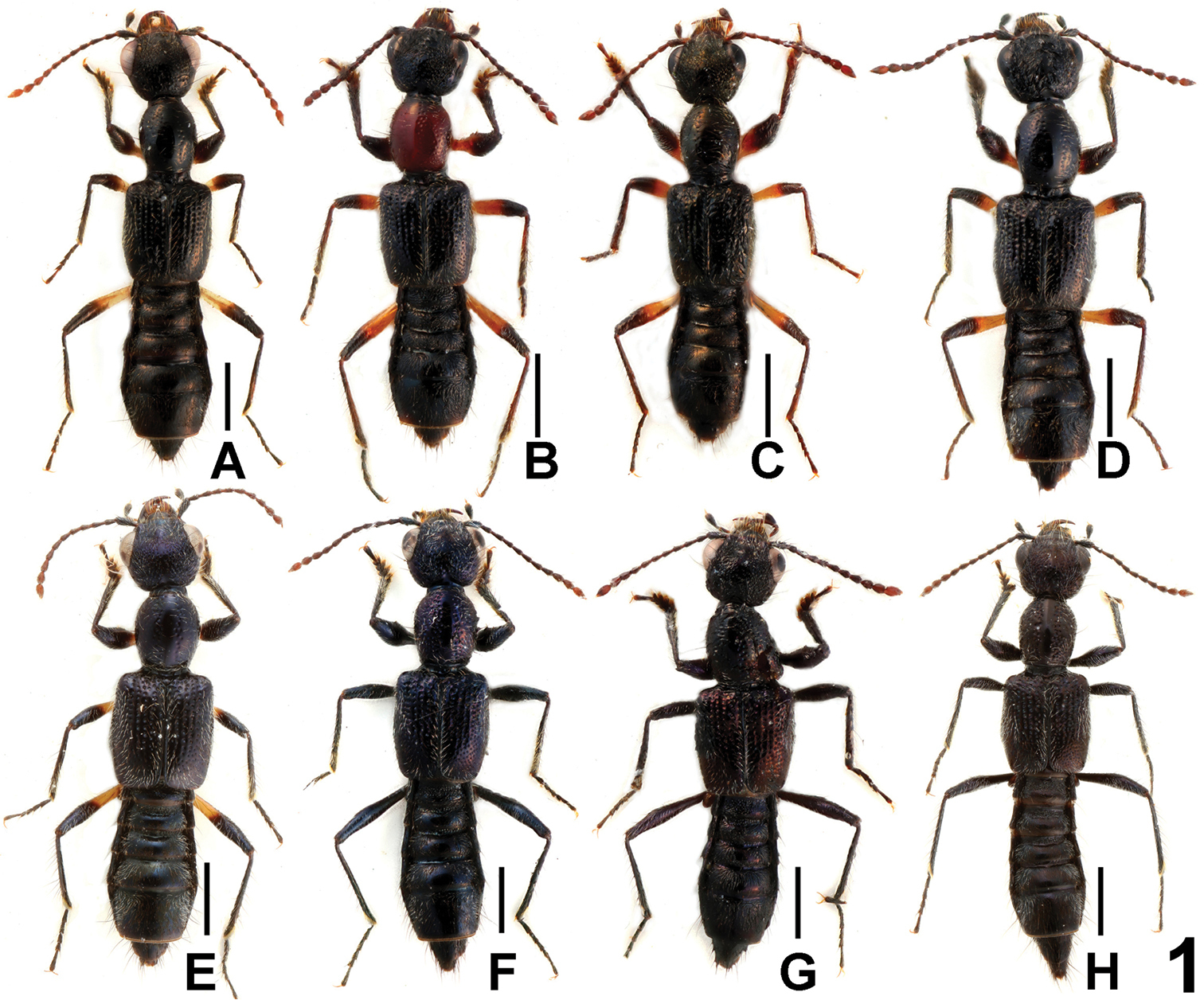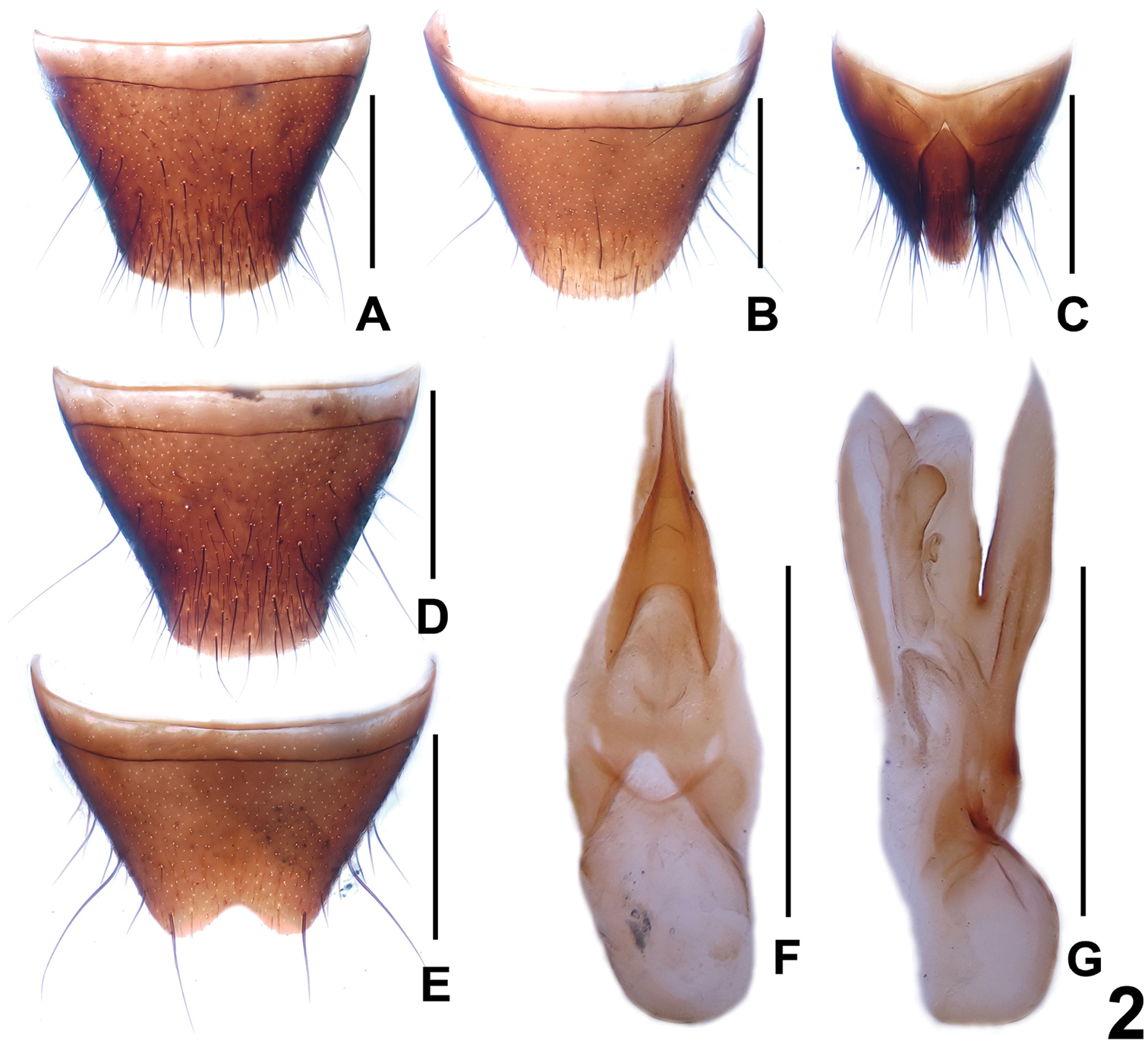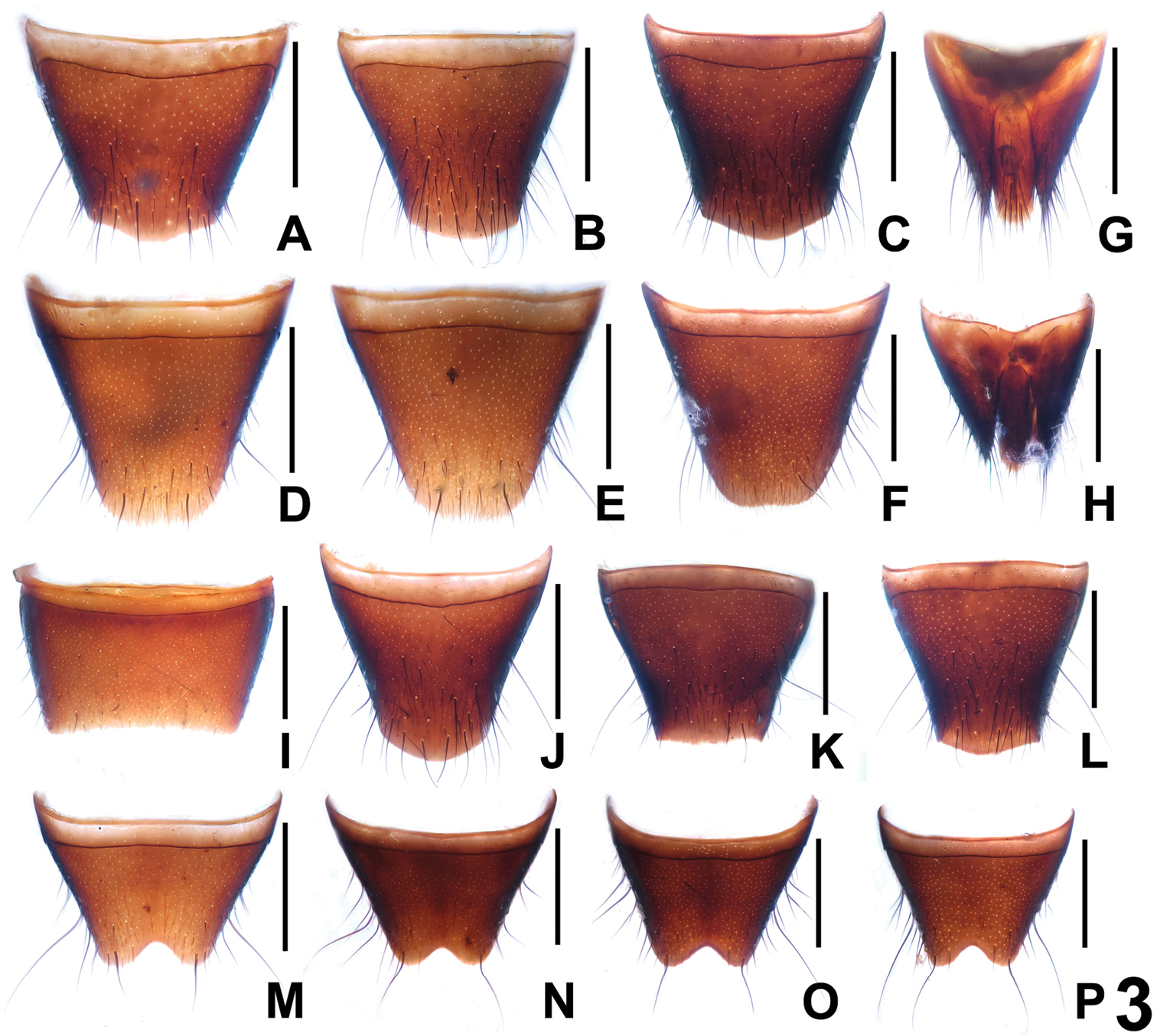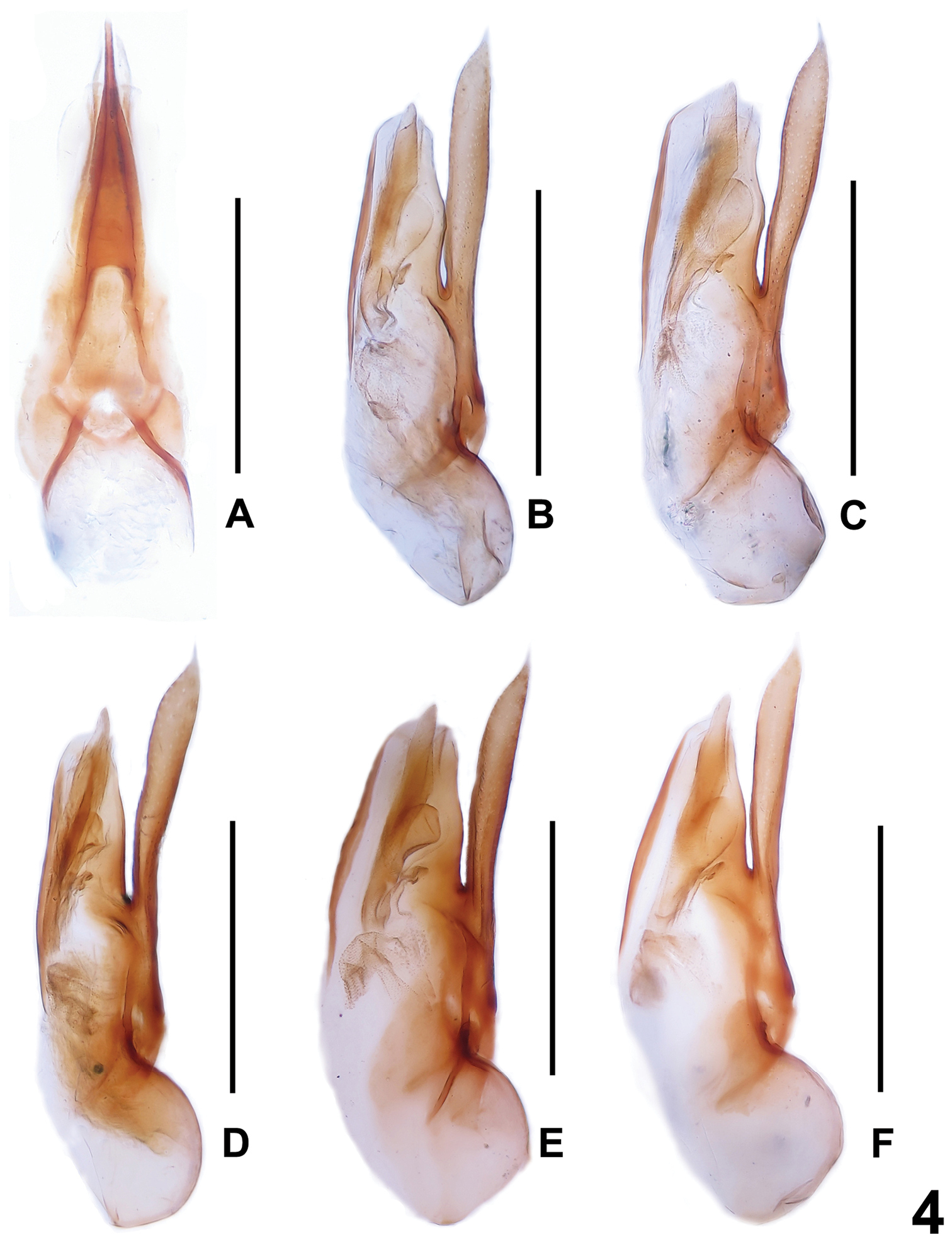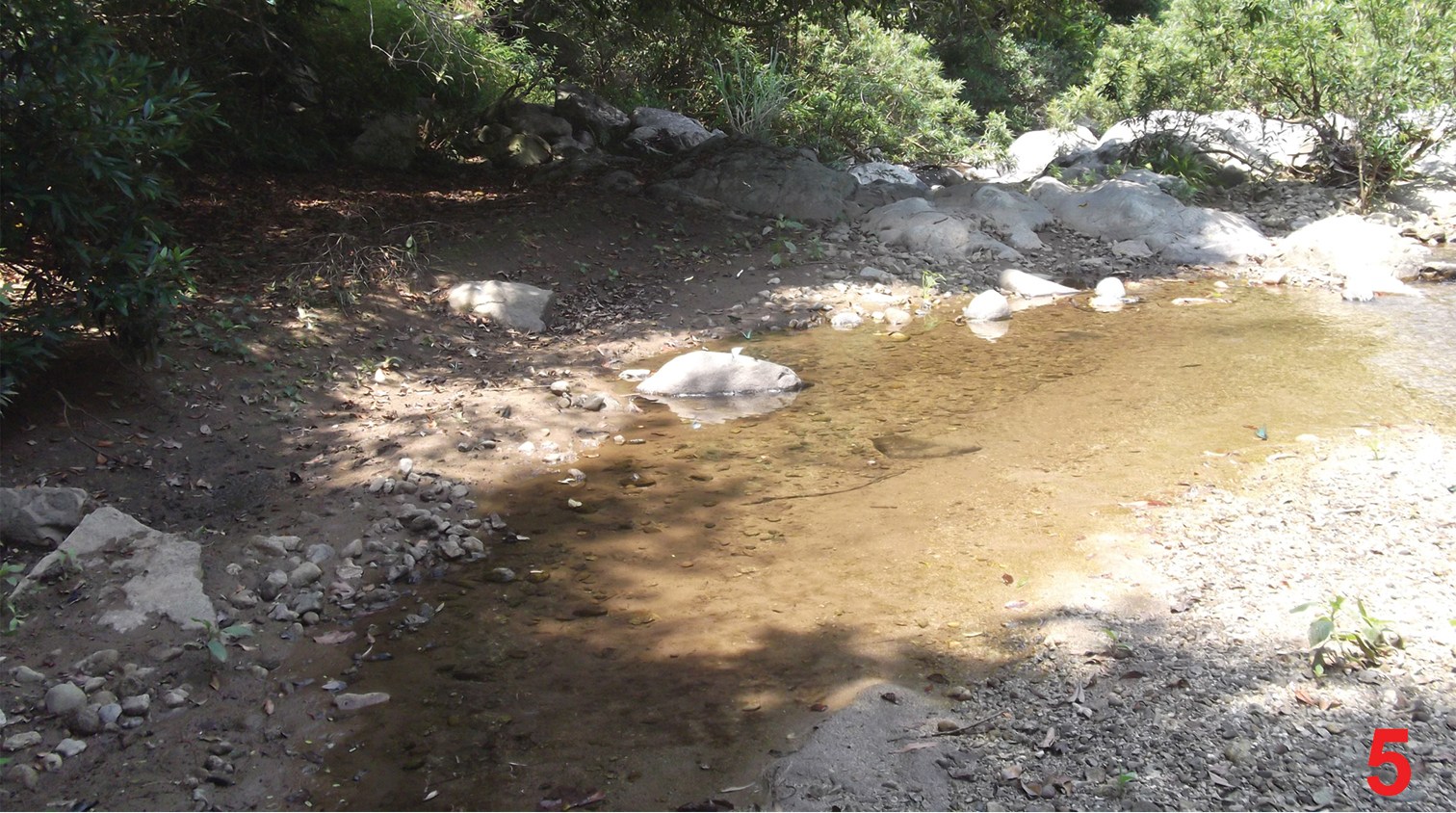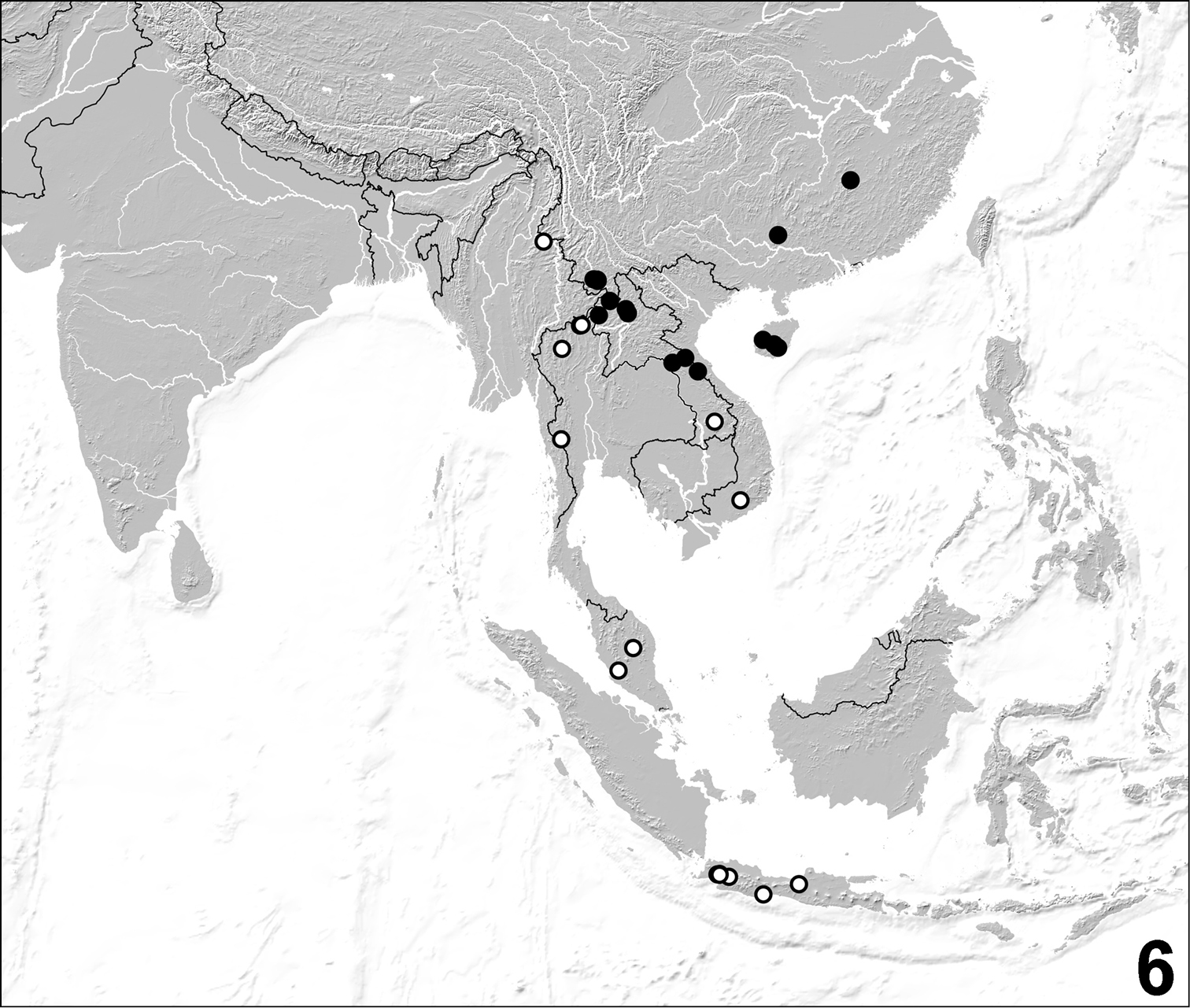






Citation: Peng Z, Assing V, Li L-Z, Zhao M-J (2014) A new species of Dysanabatium Bernhauer and additional records of D. jacobsoni Bernhauer (Coleoptera, Staphylinidae, Paederinae). ZooKeys 409: 93–102. doi: 10.3897/zookeys.409.6969
Dysanabatium hainanense Peng & Li, sp. n. (Hainan: Wuzhi Shan, Diaoluo Shan) is described and illustrated. Additional records of D. jacobsoni Bernhauer, 1915 are reported. The habitus, the sexual characters, and the distribution of this enormously variable species are illustrated.
Coleoptera, Staphylinidae, Dysanabatium, new species, new records, China
The paederine genus Dysanabatium Bernhauer, 1915 is distributed in the Oriental and southeastern Palaearctic region and was previously represented by seven species. Only one species, Dysanabatium jacobsoni Bernhauer, 1915, had been reported from China (Yunnan) (
A study of Dysanabatium material from southwestern China, Laos, and Vietnam yielded one species new to science and numerous records of Dysanabatium jacobsoni.
The examined material is deposited in the following public and private collections:
NHMB Naturhistorisches Museum Basel, Switzerland (M. Geiser, I. Zürcher)
NMP National Museum of Natural History, Praha, Czech Republic (J. Hájek)
SNUC Insect Collection of Shanghai Normal University, Shanghai, China
cAss Private collection Volker Assing, Hannover, Germany
The morphological studies were conducted using Stemi SV 11 (Zeiss Germany) and Olympus CX31 microscopes, and a Jenalab compound microscope (Carl Zeiss Jena). The images were prepared using Nikon Coolpix 995, Canon EOS 70D (with an MP-E 65 macrolens), and Canon G12 cameras. The map was created using MapCreator 2.0 (primap) software.
The following abbreviations are used in the text, with all measurements in millimeters:
Body length (BL) length of body from the anterior margin of the mandibles (in resting position) to the abdominal apex.
Forebody length (FL) length of forebody from the anterior margin of the mandibles to the posterior margin of elytra at suture.
Head length (HL) length of head from the anterior margin of the frons to the posterior margin of the head.
Head width (HW) maximum width of head (including eyes).
Antenna length (AnL) length of antenna from the basis of the antenna to the apex.
Pronotum length (PL) length of pronotum along midline.
Pronotum width (PW) maximum width of pronotum.
Elytral length (EL) at the suture from the apex of the scutellum to the posterior margin of the elytra (at the sutural angles).
Aedeagus length (AL) length of the aedeagus from the apex of the ventral process to the base of the aedeagal capsule.
http://zoobank.org/951C1265-22A1-4186-8D42-FF274643C0AF
http://species-id.net/wiki/Dysanabatium_hainanense
Figs 1A, 2, 5(8 ♂♂, 1 ♀). Holotype: ♂, labelled ‘China: Hainan Prov., 24 km NE Wuzhishan, Wuzhi Shan Guanshandian, 18°53'N, 109°40'E, alt. 650 m 19.iv.2012, Peng & Dai leg.’ (SNUC). Paratypes: 1 ♀, same label data as holotype (SNUC); 4 ♂♂, same data, but ‘18°54'N, 109°41'E, 21.iv.2012, alt. 650–700 m’ (SNUC); 2 ♂♂, same data, but ‘alt. 700 m 18.iv.2012’ (SNUC); 1 ♂, same data, but ‘Lingshui County, Diaoluo Shan, 18°43'N, 109°53'E, 25.iv.2012, alt. 950–1, 000 m’ (SNUC).
Measurements (in mm) and ratios: BL 5.89–6.43, FL 3.34–3.45, HL 0.80–0.84, HW 1.05–1.15, AnL 1.94–2.08, PL 0.93–0.98, PW 0.78–0.83, EL 1.11–1.19, AL 0.89–0.93, HL/HW 0.73–0.76, HW/PW 1.35–1.39, HL/PL 0.85–0.86, PL/PW 1.16–1.19, EL/PL 1.19–1.23, diameter of eye: 0.50–0.54.
Habitus as in Fig. 1A. Body entirely black, glossy, devoid of microsculpture; labial palpi and segments I, II, IV of maxillary palpi brownish yellow, segment III of maxillary palpi infuscate; antennae blackish brown at base, gradually becoming paler towards the reddish brown apices; basal halves of femora brownish yellow, distal halves gradually infuscate; tibia and tarsi infuscate.
Habitus of Dysanabatium spp., A Dysanabatium hainanense B–H Dysanabatium jacobsoni (B–D Yunnan; E Guangxi; F–H Hainan). Scales: 1.0 mm.
Head transverse, eyes very large and prominent, temples convergent posteriorly in almost straight line, posterior angles inconspicuous; punctation moderately coarse and dense, sparser in median dorsal portion. All antennomeres oblong.
Pronotum with strongly convex lateral margins in dorsal view; punctation shallow, sparser than that of head; impunctate midline broad.
Elytra with coarse simple punctation arranged in longitudinal series in anterior seven tenths, becoming finer and shallower posteriorly; pubescence golden, erect, conspicuous. Hind wings fully developed.
Abdomen strongly dilated from segments III to apex of segment VI, segment VII convexly tapering posteriorly; segments III–VII with strongly reflexed paratergites; punctation sparse and fine; pubescence fine and pale, with interspersed longer, darker pubescence, especially posteriorly.
Protarsi very strongly, slightly asymmetrically dilated in both sexes; profemora with bases slender, very strongly, symmetrically incrassate to apical third; outer surfaces of tibiae with pale pubescence. First metatarsomere longer than second, subequal to or slightly shorter than fifth; fourth tarsomere simple.
Male. Posterior margin of tergite VIII (Fig. 2D) broadly convex; sternites III–VI unmodified; posterior margin of sternite VII broadly concave; sternite VIII (Fig. 2E) symmetric and strongly tapering posteriorly, with moderately deep, subtriangular posterior emargination; aedeagus as in Figs 2F, G, ventral process moderately stout and apically acute; internal sac with simple membranous structures and an apically rounded, weakly sclerotized structure.
Dysanabatium hainanense. A female tergite VIII B female sternite VIII C female tergites IX–X. D male tergite VIII E male sternite VIII F aedeagus in ventral view G aedeagus in lateral view. Scales: 0.5 mm.
Female. Posterior margin of tergite VIII (Fig. 2A) asymmetrically and broadly convex; sternite VIII (Fig. 2B) longer than that of male, posterior margin broadly convex; tergite IX (Fig. 2C) with short antero-median portion and moderately long postero-lateral processes; tergite × 5.0 times as long as antero-median portion of tergite IX (Fig. 2C).
The type locality is situated in the Wuzhi Shan and Diaoluo Shan, central Hainan. The specimens from Wuzhi Shan were sifted from flood debris, moss, leaf litter and soil near streams in evergreen broad leaved forest, partly together with Dysanabatium jacobsoni Bernhauer, 1915 (Fig. 5).
The specific epithet is derived from Hainan, the province where the type locality is situated.
In external (transverse head; elongate elytra; bicolorous femora) and the male sexual characters (shapes and chaetotaxy of the male sternites VIII), Dysanabatium hainanense resembles Dysanabatium jacobsoni Bernhauer, 1915 and Dysanabatium birmana Cameron, 1931. The new species is distinguished from the former by less prominent posterior angles of the head, somewhat larger eyes, the somewhat shorter fifth metatarsomere, and the morphology of the aedeagus (different shape of ventral process and stouter sclerotized structure in internal sac). For illustrations of Dysanabatium jacobsoni see Figs 1B–H, 3A–P, 4A–F and
Tergites and sternites of Dysanabatium jacobsoni. A–C female tergite VIII D–F female sternite VIII G–H female tergites IX–X. I male sternite VII J–L male tergite VIII M–P male sternite VIII. Scales: 0.5 mm.
Aedeagus of Dysanabatium jacobsoni. A aedeagus in ventral view B–F aedeagus in lateral view (A–C Yunnan; D Guangxi; E–F Hainan). Scales: 0.5 mm.
http://species-id.net/wiki/Dysanabatium_jacobsoni
Figs 1B–H, 3–6(89 ♂♂, 104 ♀♀, 358 exx.). China: Yunnan: 40 ♂♂, 78 ♀♀, Nabanhe County, Naban, 22°10'N, 100°40'E, 650 m, 7.i.2004, Li & Tang leg. (SNUC); 10 ♂♂, 8 ♀♀, Nabanhe County, Nabanhe N. R., Manfei, 22°09'N, 100°41'E, 650 m, 9.i.2004, Li & Tang leg. (SNUC); 1 ♂, Nabanhe County, Nabanhe N. R., 620 m, 18.ix.2008, Hu & Tang leg. (SNUC); 4 ♂♂, 3 ♀♀, Nabanhe County, Nabanhe N. R., 22°10'N, 100°39'E, 720 m, 22.ix.2008, Hu & Tang leg. (SNUC); 25 ♂♂, 9 ♀♀, Nabanhe County, Mandian, 22°07'N, 100°41'E, 700 m, 12.i.2004, Li & Tang leg. (SNUC); 3 ♀♀, Xishuangbanna, Xiaonuoyouxiazhai, 22°12'N, 100°28'E, 800 m, 6.i.2004, Li & Tang leg. (SNUC). Guangxi: 1 ♂, Jinxiu County, Dayaoshan N. R., 24°08'N, 110°11'E, 850–900 m, 24.vii.2011, Peng leg. (SNUC). Jiangxi: 1 ♂, Jinggang Shan, Xiangzhou env., 26°36'N, 114°16'E, 370 m, forested stream valley, 26.iv.2011, Fikáček & Hájek leg. (NMP). Hainan: 4 ♂♂, 2 ♀♀, 24 km NE Wuzhishan, Wuzhi Shan Guanshandian, 18°53'N, 109°40'E, 650 m 19.iv.2012, Peng & Dai leg. (SNUC); 2 ♂♂, Changjiang County, Bawangling, 19°07'N, 109°07'E, 450–650 m, 13.iv.2010, Zhu leg. (SNUC); 1 ♂, Lingshui County, Diaoluo Shan, 18°43'N, 109°52'E, 900 m, 18.xi.2006, Li leg. (SNUC); 1 ♀, Lingshui County, Diaoluo Shan, 18°43'N, 109°51'E, 1000 m, 20.iv.2010, Yuan leg. (SNUC).
Vietnam: 320 exx., Quang Binh province, Vietnam-Laos border region, 1 km N Cha Lo, 17°41'N, 105°46'E, 11.–24.iv.2010, Dembický leg. (NHMB, cAss).
Laos: 9 exx., Khammouan province, Ban Khoun Ngeun, 18°07'N, 104°29'E, 200 m, 24.–29.iv.2001, Kubáň leg. (NHMB, cAss); 4 exx., Bokeo province, 5 km W Ban Toup, Bokeo Nature Reserve, 20°27–28'N, 100°45'E, 500–700 m, 4.–18.v.2011, Brancucci et al. leg. (NHMB, cAss); 13 exx., Louangphrabang province, 5 km W Ban Song Cha, 20°33–34'N, 102°14'E, 1200 m, 1.–16.v.1999, Kubáň leg. (NHMB, cAss); 1 ex., Louangphrabang province, Thong Khan, 20°33–34'N, 102°14'E, 750 m, 11.–21.v.2002, Kubáň leg. (NHMB); 6 exx., Oudomxai province, 17 km ENE Oudom Xai, 20°45'N, 102°09'E, 1100 m, 1.–9.v.2002, Kubáň leg. (NHMB, cAss); 3 exx., Bolikhamxai province, 8 km NE Ban Nape, 18°21'N, 105°08'E, 600 m, 1.–18.v.2001, Kubáň leg. (NHMB, cAss); 1 ex., Louangnamtha province, between Namtha and Muang Sing, 21°09'N, 101°19'E, 900–1200 m, 5.–31.v.1997, Kubáň leg. (NHMB); 1 ex., Champasak province, Bolaven plateau, Muang Paxong, Ban Thongvay, 15°14'N, 106°32’, 1000–1200 m, 7.–16.vi.2008, Solodovnikov & Pedersen leg. (cAss).
The original description of Dysanabatium jacobsoni is based on an unspecified number of syntypes from Java (
As was already observed by
According to
Habitat of Dysanabatium hainanense and Dysanabatium jacobsoni in the Wuzhi Shan, Hainan.
Distribution of Dysanabatium jacobsoni in the Oriental and southern East Palaearctic regions (filled circles: examined records; open circles: records from
We are indebted to the colleagues at the NHMB and the NMP for the loan of material from the collections under their care. All the collectors mentioned in the text are acknowledged for their field work. Two anonymous reviewers are thanked for comments on a previous version of the manuscript. The study is supported by the National Natural Science Foundation of China (No. 31101659 and No. 31172134, 31201734), the Foundation of Shanghai Municipal Education Commission (No. 12YZ077 and No. 13YZ062) and Shanghai Normal University (SK201234, DZL125 and B–9013–11–003127).
